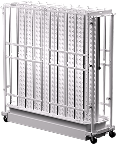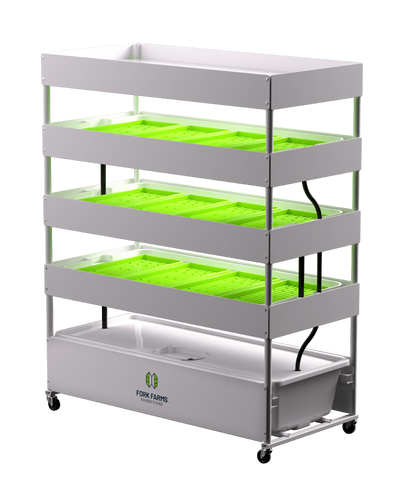An Introduction to Indoor Hydroponics
Discover indoor hydroponics and its benefits for sustainable food production. Learn the basics of hydroponics and how hydroponics farms can help build resilient local communities.
Understanding Hydroponics: A Soil-Free Approach to Plant Growth
The term hydroponics refers to the practice of growing crops without soil. In contrast to soil-based agriculture, where the plants feed by extracting nutrients from the soil, the roots of hydroponically grown plants are submersed in a nutrient solution that contains the essential minerals and compounds for healthy plant growth. In place of soil, hydroponic systems employ a soilless medium such as rockwool, coconut fibers (coir), or clay pellets to anchor the plants.
Most hydroponic systems are located indoors, giving growers exceptional control over the growing conditions. These systems can be installed in a variety of spaces, including unused rooms, vacant buildings, and areas without arable land. They can be scaled to accommodate different footprints, from a few feet to hundreds. Additionally, the systems can be configured vertically to maximize the total space available.
Hydroponics allows for efficient and controlled plant cultivation, overcoming soil quality and availability limitations. It offers the potential for higher yields, faster growth rates, and better pest and disease control. Hydroponics is a water-efficient method that minimizes environmental impact and allows year-round cultivation.
Overall, understanding the basics of hydroponics is crucial for anyone interested in sustainable and efficient plant cultivation. By harnessing the power of soil-free growing, hydroponics opens up new possibilities for agriculture and offers a more sustainable approach to feeding our growing population.
Benefits of Hydroponic Growing
Hydroponic growing offers numerous benefits, making it an attractive option for anyone looking to produce fresh food. One of the primary advantages is the ability to grow plants in any location, regardless of climate or available nutrient soil.
In traditional agriculture, the quality of soil can greatly impact plant growth. However, with hydroponics, plants can be grown in nutrient-rich solutions, ensuring optimal nutrition and eliminating the limitations imposed by poor soil conditions.
Another significant benefit of hydroponics is the potential for higher yields and faster growth rates. By providing plants with a constant supply of nutrients and water, hydroponic systems create ideal growing conditions that maximize plant productivity.
Hydroponics also allows for better control over pests and diseases. Since plants are not grown in soil, many soil-borne pests and pathogens can be avoided. Additionally, the controlled environment of hydroponic systems makes it easier to detect and address any issues that may arise.
Furthermore, hydroponics is a highly water-efficient method of growing plants. Unlike traditional soil-based gardening, which often leads to water wastage through evaporation and inefficient absorption, hydroponics recirculates water, reducing water usage and minimizing environmental impact.
Finally, hydroponics offers the potential for year-round cultivation. By creating a controlled environment, growers can adjust the temperature, light, and other factors to mimic ideal growing conditions. This allows for consistent production regardless of the season, increasing the availability of fresh produce.
In summary, the benefits of hydroponic growing are numerous and significant. From overcoming soil limitations to maximizing productivity and conserving resources, hydroponics presents a sustainable and efficient solution for modern agriculture.
Exploring Different Types of Hydroponic Systems
There are various types of hydroponic systems, each with its unique features and advantages. These systems can be classified into six main categories: Deep Water Culture (DWC), Nutrient Film Technique (NFT), Drip System, Ebb and Flow (Flood and Drain), Aeroponics, and Wick System.
Deep Water Culture (DWC) is where plants are suspended in a nutrient-rich water solution with their roots submerged. Oxygen is provided through the use of air stones or diffusers, ensuring that the roots receive the necessary oxygen for growth.
Nutrient Film Technique (NFT) is another commonly used system where a thin film of nutrient-rich water flows over the roots, providing a constant supply of nutrients. This system requires a sloping channel or gutter to enable the nutrient solution to flow continuously.
Drip System is a versatile hydroponic system that involves a slow and steady drip of nutrient solution onto the plants' roots. This system can be automated and is suitable for a wide range of plant types.
Ebb and Flow (Flood and Drain) system works by temporarily flooding the plant containers with the nutrient solution and then draining it back into a reservoir. This cyclic process ensures that the roots receive both nutrients and oxygen.
Aeroponics is similar to hydroponics. The plant's roots are suspended in air and misted with a nutrient solution in this system. This system provides optimal oxygenation for the roots, promoting rapid growth and efficient nutrient absorption.
Each system has its advantages and considerations, but all offer the benefits of soil-free plant cultivation and efficient nutrient delivery.
Building Resilient Local Communities through Hydroponics
Hydroponics has the potential to play a crucial role in building resilient local communities. By adopting hydroponics, communities can become more self-sufficient in food production and reduce their dependence on external sources.
One of the key advantages of hydroponics is its ability to grow plants in urban areas, where space may be limited. Vertical hydroponic systems allow for efficient use of space and can transform unused areas into productive food-growing zones.
In addition to urban settings, hydroponics can also benefit rural communities. Residents can collaborate and share resources by establishing community hydroponic gardens or cooperatives, enhancing food security, and fostering a sense of community.
Hydroponics also offers the potential for local fresh, nutritious food production, reducing the need for long-distance transportation and minimizing the carbon footprint associated with food distribution. This benefits the environment and provides local communities access to healthy food options.
Moreover, hydroponics can serve as an educational tool, teaching individuals of all ages about sustainable agriculture and the importance of responsible food production. By engaging with hydroponics, communities can develop skills and knowledge that contribute to their resilience and well-being.
By embracing hydroponics, local communities can build a more sustainable and resilient food system. Through collaboration, education, and innovative growing methods, hydroponics has the potential to transform communities and create a brighter future for all.
Embrace Hydroponics for Sustainable Food Production
Hydroponics represents a revolutionary way to grow plants that offers numerous benefits and advantages. By understanding the basics of hydroponics and the benefits of hydroponic growing, we can embrace this innovative method and contribute to a sustainable path forward in food production.
Hydroponics has the power to build resilient local communities by enabling food production in urban areas, creating an opportunity for collaboration and resource sharing in rural communities, and promoting local, sustainable food systems. It also serves as an educational tool that empowers individuals to become responsible food producers and contributes to community resilience.
To create a sustainable and resilient future, it is crucial to embrace the hydroponic revolution. We can cultivate plants efficiently, conserve resources, and build stronger communities by harnessing the power of soil-free growing. Let us embrace hydroponics and pave the way for a more sustainable world.
Fresh Food for All Revolution
Fork Farms is creating a better, cleaner, more efficient, and more sustainable food in our communities, one farmer at a time. The power is ours to upend the food system for good. We focused on a community-centered hydroponic farming model. Hydroponic farming should be an educational experience in your community supported by our community. With the right technology, coupled with end-to-end growing support, everyone is a farmer.
An educational hydroponic farming experience in YOUR community supported by OUR community. With the right technology, coupled with end-to-end growing support, everyone is a farmer.
The Flex Farm is the most efficient, scalable, and transformative indoor, vertical hydroponic technology on the planet. Our technology uses the best components from different hydroponic systems.
A few other advantages and highlights of Flex Farm include:
- They’re portable and only require a standard electrical outlet and less than 10 square feet of space
- Grow 25+ lbs of fresh food every 28 days
- Harvest up to 3,400 plants annually
- Requires 2 hours of regular maintenance per month
The Flex Farm is a Farm in a box and takes less than an hour to set up. Ideal for beginners, it comes with everything you need to start farming. It has a fully self-contained water system, energy-efficient LED light tower, submersible pump, Grower Toolkit, and Starter Supplies Box.
At Fork Farms, we are using proven technology, expertise, and strategic partnerships to ensure that fresh food can be delivered to more people in more places through a fresh and innovative approach to farming.























